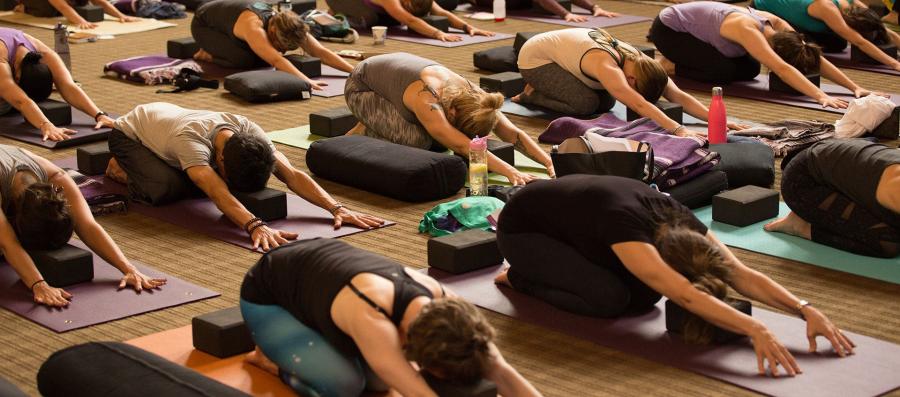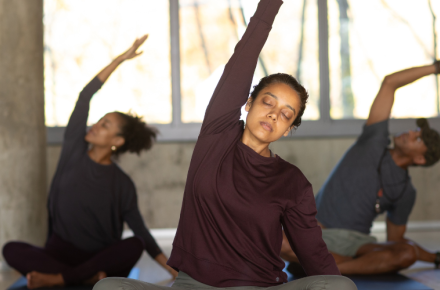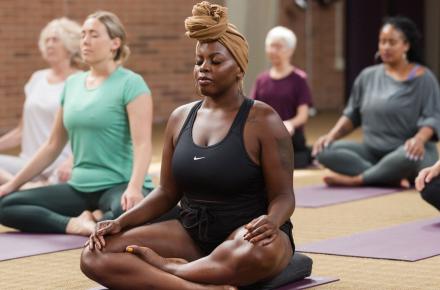Muscle, Fascia, and Yoga: We Are All Connective

“That was fascinating!” exclaimed a guest at the conclusion of Christopher Holmes’ R&R workshop, Muscle, Fascia, and Yoga, and for good reason. Chris, a Kripalu Yoga teacher and bodyworker with more than 20 years’ experience, is easygoing and knowledgeable, with a friendly demeanor and a soothing voice. He led a 90-minute presentation that was equal parts experiential and educational, offering an engaging, accessible mix of lecture, practice, and anatomy lesson. His enthusiasm for biomechanics is infectious.
So what is fascia, exactly, and how does learning about it add value to our yoga practice? Commonly known as connective tissue, fascia is the fluid, translucent, web-like thread that glues marrow and bone and wraps around muscle like cellophane casing. “Fascia is a tensioned fabric that allows us to move,” Chris explains.
Scientists have only recently begun to unravel the true function of fascia. When cadavers were first being examined centuries ago—and even well into the modern era—fascia was believed to be “dead packaging.” But thanks to recent discoveries, fascia has proven to be anything but—it’s a living organism that not only cocoons muscle, but also communicates with it. And the language spoken between muscle and fascia is movement.
Fascia is so fundamental to our physical architecture because, as Chris puts it, it acts as the body’s scaffolding; fascia keeps us upright and gives us our shape. “Our muscles and bones float inside the fascia,” Chris notes.
Fascia has the property of plasticity, and thus reacts positively to the heat generated by muscle contraction, allowing it to become more fluid and mobile. That’s why gradual warm-ups that open the body are necessary for a sustainable yoga practice. As Chris notes, “From a yogic perspective, prana, the life-force energy, is embedded in the fascia, so awakening the fascial wrapping puts us into a deeper relationship with prana.” The warmer the fascia, the more elastic it becomes, and that plasticity makes fascia a conduit for prana to flow freely.
Fascia becomes supple when moved, but stiffens when sedentary—think about how your body feels upon waking as opposed to the busiest time of your day. This is why it’s important to remain active and mobile throughout our lives—to keep our connective tissue fluid and healthy. Spending countless hours sitting at desks or in cars shortens our muscles and dehydrates our connective tissue.
In asana practice, fascia and muscle work together to create tone—which Chris defines as the balance of mobility and strength. Yoga can help reorganize the fascial plane, by, as Chris puts it, “melting the body out of hurt.”
Chris offers a formula to help the fascia and muscles open to their fullest capacity: Warm, Load, and Rest. Warm is the gradual increasing of range of motion—think supine twists, seated hip circles—that prepares us for deeper practice. After the body is warmed up, powerful postures, such as Warrior, and challenging balances, such as Tree pose, can strengthen and engage the muscles by elongating the fascia. Afterward comes rest—Savasana or a body scan—when you settle in, soften, and notice the effects on your body.
Next time you step onto your mat, give a nod of gratitude to your fabulous fascia, and see if visualizing the web that connects and shapes your body can refine your awareness of your entire being.
Find out about upcoming programs with Christopher Holmes at Kripalu.
© Kripalu Center for Yoga & Health. All rights reserved. To request permission to reprint, please email editor@kripalu.org.













































